Entry Database : PDB / ID : 3l0eTitle X-ray crystal structure of a Potent Liver X Receptor Modulator Nuclear receptor coactivator 2 Oxysterols receptor LXR-beta Keywords / / / / / / / / / / / Function / homology Function Domain/homology Component
/ / / / / / / / / / / / / / / / / / / / / / / / / / / / / / / / / / / / / / / / / / / / / / / / / / / / / / / / / / / / / / / / / / / / / / / / / / / / / / / / / / / / / / / / / / / / / / / / / / / / / / / / / / / / / / / / / / / / / / / / / / / / / / / / / / / / / / / / / / / / / / / / / / / / / / / Biological species Homo sapiens (human)Method / / / Resolution : 2.3 Å Authors Gampe Jr., R.T. Journal : J.Med.Chem. / Year : 2010Title : Discovery of tertiary sulfonamides as potent liver X receptor antagonists.Authors: Zuercher, W.J. / Buckholz, R.G. / Campobasso, N. / Collins, J.L. / Galardi, C.M. / Gampe, R.T. / Hyatt, S.M. / Merrihew, S.L. / Moore, J.T. / Oplinger, J.A. / Reid, P.R. / Spearing, P.K. / ... Authors : Zuercher, W.J. / Buckholz, R.G. / Campobasso, N. / Collins, J.L. / Galardi, C.M. / Gampe, R.T. / Hyatt, S.M. / Merrihew, S.L. / Moore, J.T. / Oplinger, J.A. / Reid, P.R. / Spearing, P.K. / Stanley, T.B. / Stewart, E.L. / Willson, T.M. History Deposition Dec 9, 2009 Deposition site / Processing site Revision 1.0 Apr 7, 2010 Provider / Type Revision 1.1 Jul 13, 2011 Group / Refinement description / Version format complianceRevision 1.2 Nov 1, 2017 Group / Category Revision 1.3 Oct 13, 2021 Group / Derived calculations / Category / struct_ref_seq_dif / struct_siteItem _database_2.pdbx_DOI / _database_2.pdbx_database_accession ... _database_2.pdbx_DOI / _database_2.pdbx_database_accession / _struct_ref_seq_dif.details / _struct_site.pdbx_auth_asym_id / _struct_site.pdbx_auth_comp_id / _struct_site.pdbx_auth_seq_id Revision 1.4 Sep 6, 2023 Group / Refinement descriptionCategory / chem_comp_bond / pdbx_initial_refinement_model
Show all Show less
 Open data
Open data Basic information
Basic information Components
Components Keywords
Keywords TRANSCRIPTION / hLXR-beta / human Liver X Receptor-beta / sulfonamide modulator / DNA-binding / Metal-binding /
TRANSCRIPTION / hLXR-beta / human Liver X Receptor-beta / sulfonamide modulator / DNA-binding / Metal-binding /  Nucleus / Receptor /
Nucleus / Receptor /  Transcription regulation /
Transcription regulation /  Zinc-finger / Activator /
Zinc-finger / Activator /  Phosphoprotein
Phosphoprotein Function and homology information
Function and homology information aryl hydrocarbon receptor binding / positive regulation of cholesterol efflux / negative regulation of macrophage derived foam cell differentiation / regulation of lipid metabolic process / cellular response to Thyroglobulin triiodothyronine / regulation of glucose metabolic process / Synthesis of bile acids and bile salts / Endogenous sterols / Synthesis of bile acids and bile salts via 27-hydroxycholesterol / Synthesis of bile acids and bile salts via 7alpha-hydroxycholesterol / nuclear retinoid X receptor binding / NR1H3 & NR1H2 regulate gene expression linked to cholesterol transport and efflux / Recycling of bile acids and salts / regulation of cellular response to insulin stimulus / cellular response to hormone stimulus / positive regulation of adipose tissue development / peroxisome proliferator activated receptor signaling pathway / RORA activates gene expression / VLDLR internalisation and degradation / positive regulation of protein metabolic process / Regulation of lipid metabolism by PPARalpha / hormone-mediated signaling pathway / cholesterol homeostasis / BMAL1:CLOCK,NPAS2 activates circadian gene expression / SUMOylation of transcription cofactors / nuclear receptor coactivator activity / Activation of gene expression by SREBF (SREBP) / response to progesterone /
aryl hydrocarbon receptor binding / positive regulation of cholesterol efflux / negative regulation of macrophage derived foam cell differentiation / regulation of lipid metabolic process / cellular response to Thyroglobulin triiodothyronine / regulation of glucose metabolic process / Synthesis of bile acids and bile salts / Endogenous sterols / Synthesis of bile acids and bile salts via 27-hydroxycholesterol / Synthesis of bile acids and bile salts via 7alpha-hydroxycholesterol / nuclear retinoid X receptor binding / NR1H3 & NR1H2 regulate gene expression linked to cholesterol transport and efflux / Recycling of bile acids and salts / regulation of cellular response to insulin stimulus / cellular response to hormone stimulus / positive regulation of adipose tissue development / peroxisome proliferator activated receptor signaling pathway / RORA activates gene expression / VLDLR internalisation and degradation / positive regulation of protein metabolic process / Regulation of lipid metabolism by PPARalpha / hormone-mediated signaling pathway / cholesterol homeostasis / BMAL1:CLOCK,NPAS2 activates circadian gene expression / SUMOylation of transcription cofactors / nuclear receptor coactivator activity / Activation of gene expression by SREBF (SREBP) / response to progesterone /  nuclear receptor binding / negative regulation of proteolysis / circadian regulation of gene expression / SUMOylation of intracellular receptors / Heme signaling / mRNA transcription by RNA polymerase II / Activated PKN1 stimulates transcription of AR (androgen receptor) regulated genes KLK2 and KLK3 / Transcriptional activation of mitochondrial biogenesis / PPARA activates gene expression / Cytoprotection by HMOX1 / chromatin DNA binding / Transcriptional regulation of white adipocyte differentiation / positive regulation of miRNA transcription / Nuclear Receptor transcription pathway / RNA polymerase II transcription regulator complex /
nuclear receptor binding / negative regulation of proteolysis / circadian regulation of gene expression / SUMOylation of intracellular receptors / Heme signaling / mRNA transcription by RNA polymerase II / Activated PKN1 stimulates transcription of AR (androgen receptor) regulated genes KLK2 and KLK3 / Transcriptional activation of mitochondrial biogenesis / PPARA activates gene expression / Cytoprotection by HMOX1 / chromatin DNA binding / Transcriptional regulation of white adipocyte differentiation / positive regulation of miRNA transcription / Nuclear Receptor transcription pathway / RNA polymerase II transcription regulator complex /  nuclear receptor activity /
nuclear receptor activity /  Circadian Clock / HATs acetylate histones /
Circadian Clock / HATs acetylate histones /  ATPase binding / DNA-binding transcription activator activity, RNA polymerase II-specific / Estrogen-dependent gene expression /
ATPase binding / DNA-binding transcription activator activity, RNA polymerase II-specific / Estrogen-dependent gene expression /  transcription regulator complex /
transcription regulator complex /  cell differentiation /
cell differentiation /  transcription coactivator activity /
transcription coactivator activity /  protein dimerization activity /
protein dimerization activity /  nuclear body / DNA-binding transcription factor activity, RNA polymerase II-specific / RNA polymerase II cis-regulatory region sequence-specific DNA binding / protein domain specific binding / negative regulation of DNA-templated transcription /
nuclear body / DNA-binding transcription factor activity, RNA polymerase II-specific / RNA polymerase II cis-regulatory region sequence-specific DNA binding / protein domain specific binding / negative regulation of DNA-templated transcription /  chromatin binding /
chromatin binding /  chromatin / regulation of DNA-templated transcription / positive regulation of DNA-templated transcription / negative regulation of transcription by RNA polymerase II / positive regulation of transcription by RNA polymerase II / protein-containing complex /
chromatin / regulation of DNA-templated transcription / positive regulation of DNA-templated transcription / negative regulation of transcription by RNA polymerase II / positive regulation of transcription by RNA polymerase II / protein-containing complex /  DNA binding / zinc ion binding /
DNA binding / zinc ion binding /  nucleoplasm /
nucleoplasm /  nucleus /
nucleus /  cytosol /
cytosol /  cytoplasm
cytoplasm
 Homo sapiens (human)
Homo sapiens (human) X-RAY DIFFRACTION /
X-RAY DIFFRACTION /  SYNCHROTRON /
SYNCHROTRON /  MOLECULAR REPLACEMENT / Resolution: 2.3 Å
MOLECULAR REPLACEMENT / Resolution: 2.3 Å  Authors
Authors Citation
Citation Journal: J.Med.Chem. / Year: 2010
Journal: J.Med.Chem. / Year: 2010 Structure visualization
Structure visualization Molmil
Molmil Jmol/JSmol
Jmol/JSmol Downloads & links
Downloads & links Download
Download 3l0e.cif.gz
3l0e.cif.gz PDBx/mmCIF format
PDBx/mmCIF format pdb3l0e.ent.gz
pdb3l0e.ent.gz PDB format
PDB format 3l0e.json.gz
3l0e.json.gz PDBx/mmJSON format
PDBx/mmJSON format Other downloads
Other downloads https://data.pdbj.org/pub/pdb/validation_reports/l0/3l0e
https://data.pdbj.org/pub/pdb/validation_reports/l0/3l0e ftp://data.pdbj.org/pub/pdb/validation_reports/l0/3l0e
ftp://data.pdbj.org/pub/pdb/validation_reports/l0/3l0e
 Links
Links Assembly
Assembly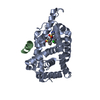

 Components
Components
 Homo sapiens (human) / Gene: NR1H2, LXRB, NER, UNR / Production host:
Homo sapiens (human) / Gene: NR1H2, LXRB, NER, UNR / Production host: 
 Escherichia coli (E. coli) / Strain (production host): BL21(DE3) / References: UniProt: P55055
Escherichia coli (E. coli) / Strain (production host): BL21(DE3) / References: UniProt: P55055 / NCoA-2 / Transcriptional intermediary factor 2 / hTIF2
/ NCoA-2 / Transcriptional intermediary factor 2 / hTIF2 Water
Water X-RAY DIFFRACTION / Number of used crystals: 1
X-RAY DIFFRACTION / Number of used crystals: 1  Sample preparation
Sample preparation
 SYNCHROTRON / Site:
SYNCHROTRON / Site:  APS
APS  / Beamline: 23-ID-B / Wavelength: 1 Å
/ Beamline: 23-ID-B / Wavelength: 1 Å : 1 Å / Relative weight: 1
: 1 Å / Relative weight: 1  Processing
Processing :
:  MOLECULAR REPLACEMENT
MOLECULAR REPLACEMENT Movie
Movie Controller
Controller



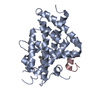


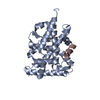
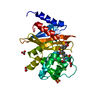
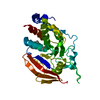

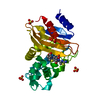
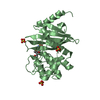
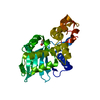
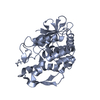
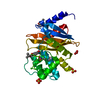
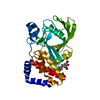
 PDBj
PDBj














